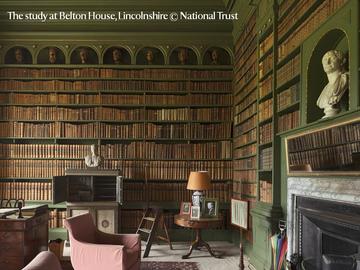Our Collections and their Audiences
Our Collections and their Audiences: The National Trust and University of Oxford muse on the challenges involved in showcasing their collections
On Thursday 9th March, National Trust staff and researchers from Oxford University came together for the third lecture in the MOVING, TEACHING, INSPIRING series. The evening saw a thought-provoking dialogue on museum collections and visitor engagement between Simon Murray, Senior Director for Strategy, Curatorship & External Affairs at the National Trust, and Dr Xa Sturgis, Director of the Ashmolean Museum.
Simon Murray began the discussion with a presentation about the National Trust’s aim to give visitors a more emotionally rewarding and intellectually stimulating experience. As he pointed out, the greatest challenge facing National Trust properties and collections is that they are often considered to be irrelevant or uninteresting to many audiences. More disheartening still, market research has shown that a number of visitors leave National Trust places feeling disappointed about the lack of intellectual or emotional content in their visit. These are very real and worrying issues which the charity is dedicated to overcoming.
For Simon, the most important way of making National Trust collections relevant to audiences is not to change or disrupt the properties themselves, but rather to “give people eyes to see”. In other words, it’s about bestowing upon visitors a greater contextual understanding of places and their significance. This, Simon hopes, will allow visitors a “gateway” into the National Trust and encourage a more active engagement with its properties, places and historic collections.
Simon continually emphasised the importance of relevance: the need to make bold and confident statements about current subjects and to avoid shying away from potentially provocative themes. In support of this the charity has embarked upon a National Public Programming strategy which will explore key themes and histories annually across its diverse portfolio. Beginning with LGBTQ heritage in 2017, followed by women’s history (2018) and Radical Landscapes (2019), this strategy aims to offer visitors the opportunity to reflect upon challenging histories through National Trust places and collections.
Simon went on to address the role of digital technologies in enhancing visitor experience, highlighting in particular the Trusted Source Knowledge Transfer Partnership currently running between Oxford and the National Trust which is creating an online resource of concise and accessible articles that help visitors better engage with the key ideas, histories and people related to the charity, its places and collections. Of equal importance is social media, as well as the idea of giving visitors a choice of different interpretations to choose from. All of this, Simon concluded, will be fundamental to fulfilling the National Trust’s visitor-oriented goals: to overcome passive visitor experiences, and to encourage more active exploration and engagement with the National Trust and its portfolio.
Dr Xa Sturgis went on to highlight the very similar situation facing the Ashmolean Museum. The extraordinary breadth and depth of the museum’s collections present unique challenges in how to encourage active visitor engagement. Xa explained that, although the structure of visitors’ encounters with the Asmolean’s collections are very similar, the actual content of visitor encounters varies greatly from person to person. This highly subjective experience fundamentally limits the ways museums can encourage viewers to engage with an object. The problem is a simple one; while certain interpretation approaches may entice some visitors, the very same tactics may well put off others.
In attempting to overcome this conundrum, Xa mused on the opportunities offered by digital media that give agency to visitors to decide what information they want to access for a given object. However, on a concluding note which rang harmoniously with Simon’s speech, Xa ended by claiming that what people need in order to understand and engage with a museum object is the act of curation. Xa then rounded off by telling us what the Ashmolean is seeking to do in this vein. This includes creating a bank of podcasts (Thinking with Things) in which Oxford academics choose an item from the museum’s collection and approach it from their own disciplinary perspective, as well as a plan to redisplay founding objects in more dramatic and theatrical ways.
Questions from the audience were focused chiefly on how the two institutions would achieve the goal of opening up objects which are particularly inaccessible to the general public, as well as how the National Trust would reconcile the need to attract new visitors while retaining its loyal client bases. Simon and Xa both acknowledged items which are particularly difficult for visitors to engage with (libraries for the National Trust; coins in the case of the Ashmolean). However, both speakers were also optimistic that even the most inaccessible items can be made interesting. Simon linked back to the need to give visitors a ‘frame’ through which to see the collection, and suggested that giving visitors information about the individual who compiled the library would provide a means of accessing some of the National Trust’s less inviting bibliographic collections. Xa argued that though physical items can be challenging, it is more fruitful to view them as having great potential, especially in their ability to link people to the past and to distant cultures.
A question was also asked about the implications of Brexit for the respective institutions’ agendas, and both Simon and Xa agreed on the duty of museums to wave multi-cultural flags and to showcase European connections in their collections. Now, perhaps more than ever in recent history, is a time when Oxford University and the National Trust should not be afraid to ‘make bold statements.’
- Ben Kehoe, DPhil Candidate in History and Trusted Source contributor.
The next lecture in the MOVING, TEACHING, INSPIRING series – Heritage as Business – is at 5.30pm on Thursday 4th May 2017, St Luke’s Chapel. Full details about this lecture and all others in the series here.
Places are limited, therefore booking is essential. Please RSVP to Alice Purkiss



